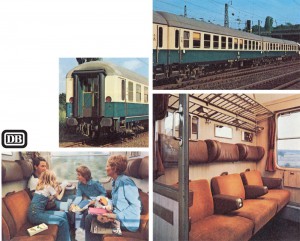What exactly was a long distance train like in the 1970s?
Each country in Europe had a national railroad (and possibly some private railroads as well). It was typically the national railroad that ran the long-distance trains and any international traffic.
![]() Most train cars used in long distance service were similar in layout: At the ends were vestibules with doors to the outside, as well as doors to allow passage to the next train car. A toilet and often a wash room were also located in the vestibule.
Most train cars used in long distance service were similar in layout: At the ends were vestibules with doors to the outside, as well as doors to allow passage to the next train car. A toilet and often a wash room were also located in the vestibule.
From the vestibule, you entered a corridor that ran down the side of the train car. From it you could enter any one of 9 to 12 compartments (the number depending on the car’s type). Older cars often had 8 seats per compartment, newer ones 6. The wall to the compartments had plenty of glass, although there were curtains that could be pulled if one didn’t want to be seen by everyone walking by (handy at night when trying to catch some shut-eye).
Sliding doors provided entry into the compartments. Right next to the door was a small frame with numbers. If a seat in the compartment was reserved, it would be indicated on a paper strip inserted into this frame. You learned to check for those things.
 Inside the compartment were either 2 benches or 6 individual seats. The quick lesson was benches are bad and individual seats are good. Those seats pulled out, allowing the traveler to enjoy a reclined position. 2 facing seats could be pulled out to provide a place to lie down. That way 3 people could comfortably lie down in a compartment for night travel. If there were 6 of you in there, you’d better be good friends as things got a bit snug.
Inside the compartment were either 2 benches or 6 individual seats. The quick lesson was benches are bad and individual seats are good. Those seats pulled out, allowing the traveler to enjoy a reclined position. 2 facing seats could be pulled out to provide a place to lie down. That way 3 people could comfortably lie down in a compartment for night travel. If there were 6 of you in there, you’d better be good friends as things got a bit snug.
Each seat had a headrest, often adjustable. The window seats and sometimes the aisle seats had small folding tables, just big enough for lunch.
Over the seats was a shelf for hats and small luggage items, and above it, a larger luggage shelf. After a while, you learned the right swing to hoist a fully loaded backpack up there without dropping it. There was also luggage space under the seats in many cars.
The windows back then opened, with the top half sliding down. You could hang out the window for fresh air or to wave goodbye to old or new friends as the train left the station. There was of course no air conditioning, so being able to open the window was a good thing.
During the trip, the compartment often became a world of its own. It was a place where great friendships were made, that lasted long after the journey was over. Or it was a place to get some rest, catch up on reading or just watch the world roll by outside the window. But after many cities, towns and youth hostels, there was something that felt like home about a train car compartment.



One Comment